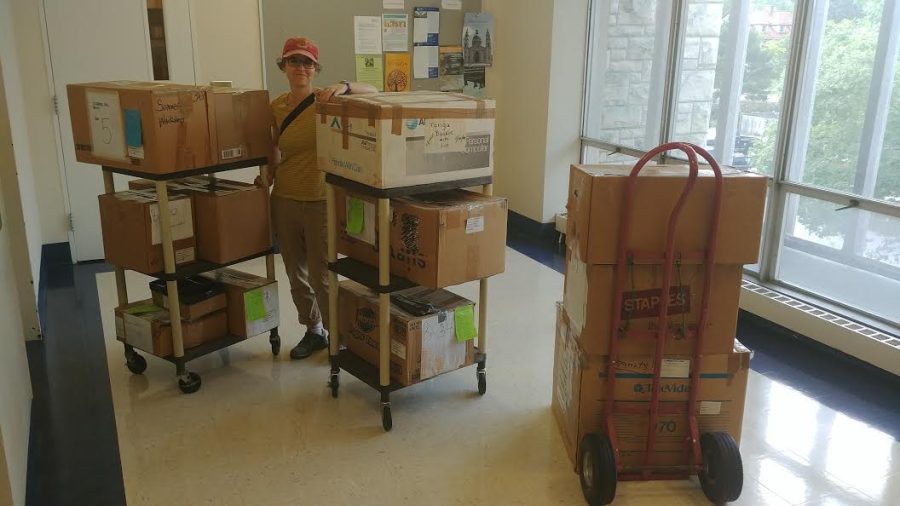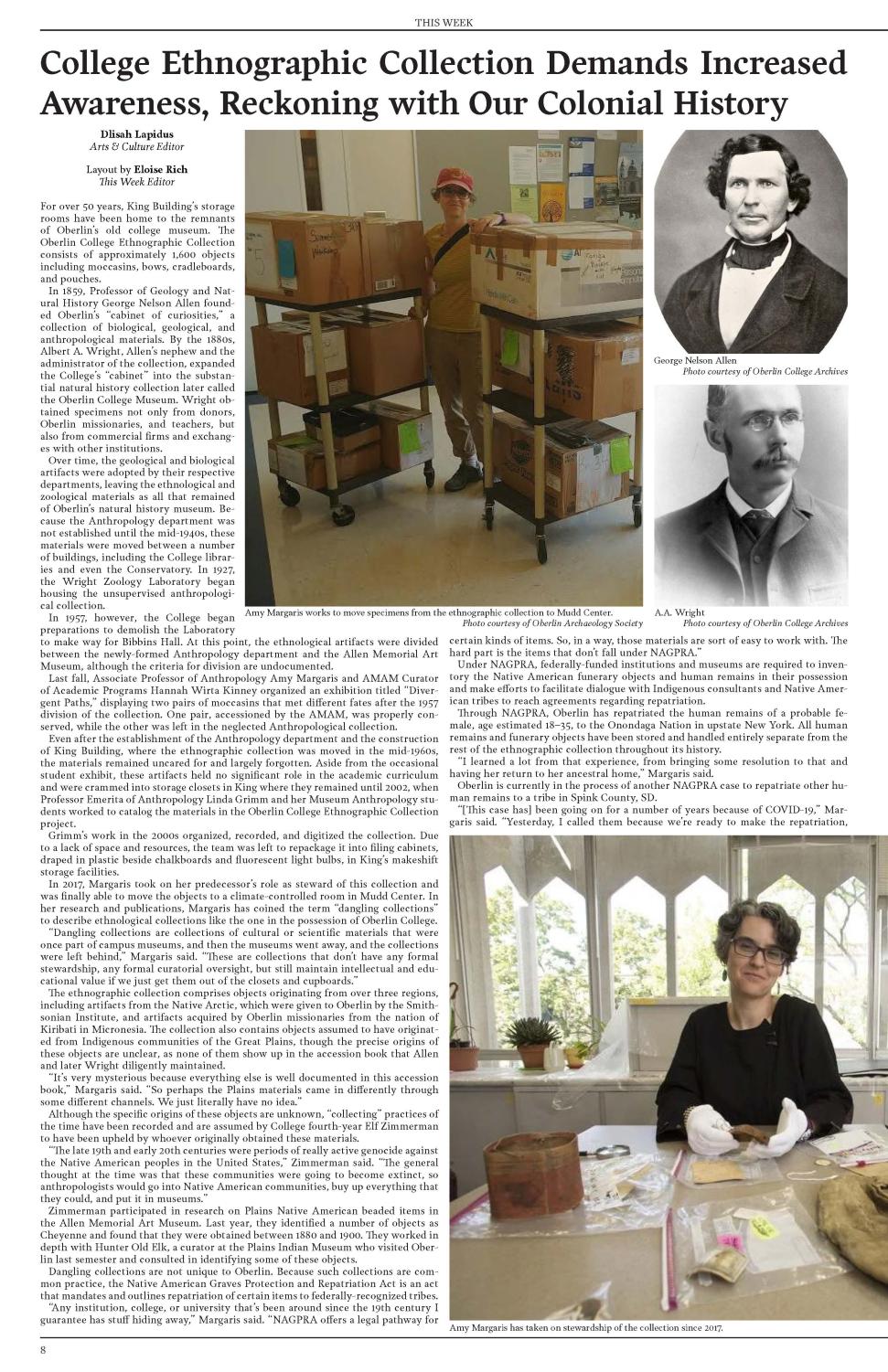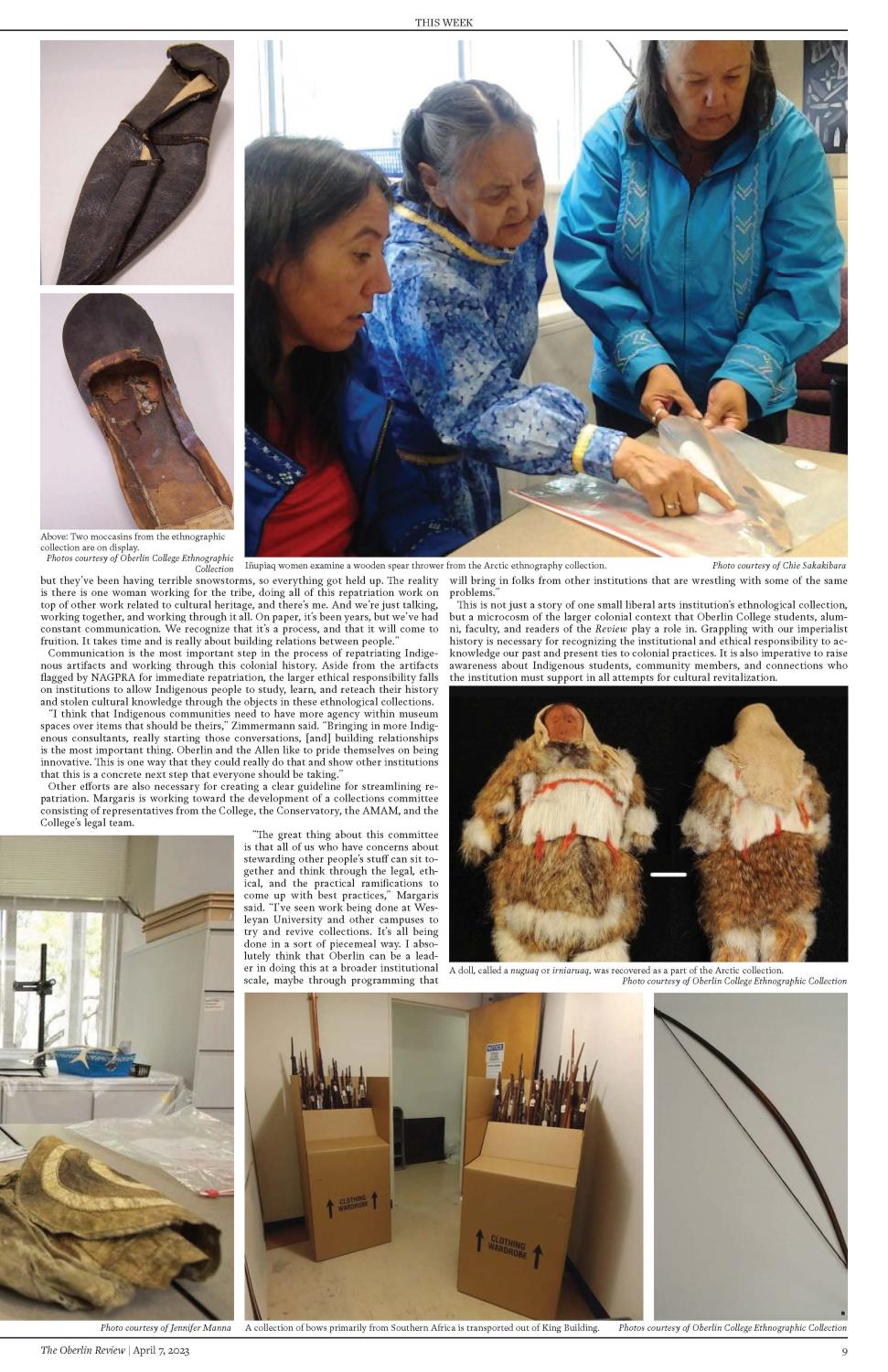College Ethnographic Collection Demands Increased Awareness, Reckoning with Our Colonial History
Photo courtesy of Oberlin Archaeology Society
Amy Margaris works to move specimens from the ethnographic collection to Mudd Center.
For over 50 years, King Building’s storage rooms have been home to the remnants of Oberlin’s old college museum. The Oberlin College Ethnographic Collection consists of approximately 1,600 objects including moccasins, bows, cradleboards, and pouches.
In 1859, Professor of Geology and Natural History George Nelson Allen founded Oberlin’s “cabinet of curiosities,” a collection of biological, geological, and anthropological materials. By the 1880s, Albert A. Wright, Allen’s nephew and the administrator of the collection, expanded the College’s “cabinet” into the substantial natural history collection later called the Oberlin College Museum. Wright obtained specimens not only from donors, Oberlin missionaries, and teachers, but also from commercial firms and exchanges with other institutions.
Over time, the geological and biological artifacts were adopted by their respective departments, leaving the ethnological and zoological materials as all that remained of Oberlin’s natural history museum. Because the Anthropology department was not established until the mid-1940s, these materials were moved between a number of buildings, including the College libraries and even the Conservatory. In 1927, the Wright Zoology Laboratory began housing the unsupervised anthropological collection.
In 1957, however, the College began preparations to demolish the Laboratory to make way for Bibbins Hall. At this point, the ethnological artifacts were divided between the newly-formed Anthropology department and the Allen Memorial Art Museum, although the criteria for division are undocumented.
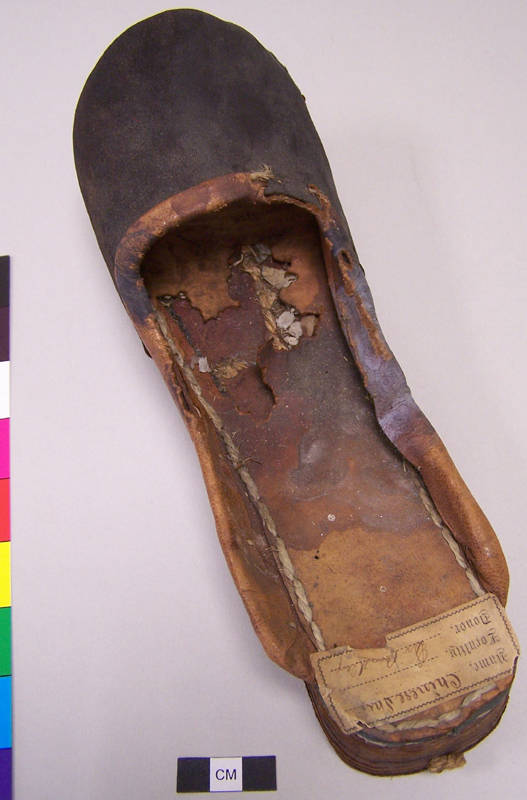
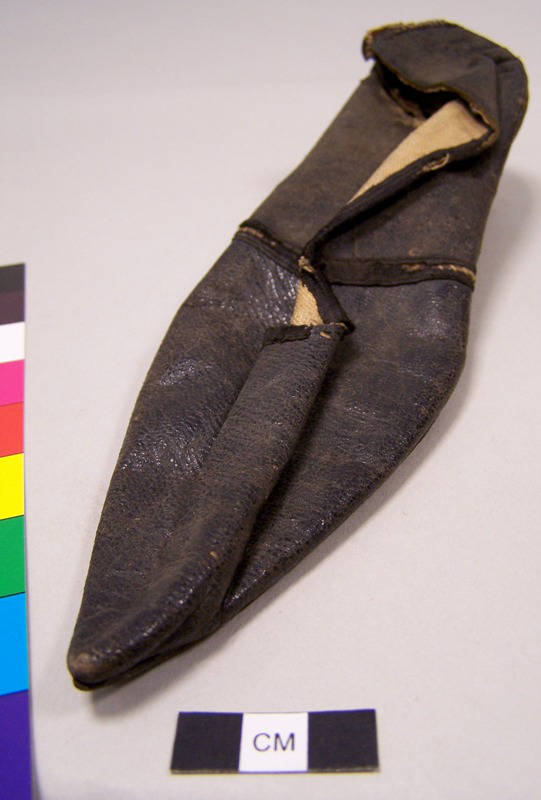 Last fall, Associate Professor of Anthropology Amy Margaris and AMAM Curator of Academic Programs Hannah Wirta Kinney organized an exhibition titled “Divergent Paths,” displaying two pairs of moccasins that met different fates after the 1957 division of the collection. One pair, accessioned by the AMAM, was properly conserved, while the other was left in the neglected Anthropological collection.
Last fall, Associate Professor of Anthropology Amy Margaris and AMAM Curator of Academic Programs Hannah Wirta Kinney organized an exhibition titled “Divergent Paths,” displaying two pairs of moccasins that met different fates after the 1957 division of the collection. One pair, accessioned by the AMAM, was properly conserved, while the other was left in the neglected Anthropological collection.
Even after the establishment of the Anthropology department and the construction of King Building, where the ethnographic collection was moved in the mid-1960s, the materials remained uncared for and largely forgotten. Aside from the occasional student exhibit, these artifacts held no significant role in the academic curriculum and were crammed into storage closets in King where they remained until 2002, when Professor Emerita of Anthropology Linda Grimm and her Museum Anthropology students worked to catalog the materials in the Oberlin College Ethnographic Collection project.
Grimm’s work in the 2000s organized, recorded, and digitized the collection. Due to a lack of space and resources, the team was left to repackage it into filing cabinets, draped in plastic beside chalkboards and fluorescent light bulbs, in King’s makeshift storage facilities.
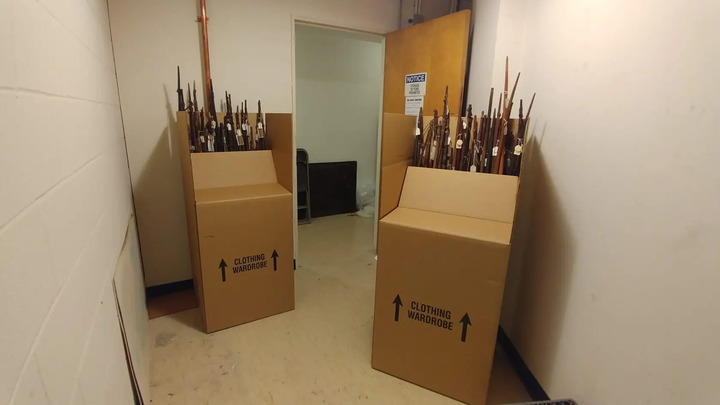
In 2017, Margaris took on her predecessor’s role as steward of this collection and was finally able to move the objects to a climate-controlled room in Mudd Center. In her research and publications, Margaris has coined the term “dangling collections” to describe ethnological collections like the one in the possession of Oberlin College.
“Dangling collections are collections of cultural or scientific materials that were once part of campus museums, and then the museums went away, and the collections were left behind,” Margaris said. “These are collections that don’t have any formal stewardship, any formal curatorial oversight, but still maintain intellectual and educational value if we just get them out of the closets and cupboards.”
The ethnographic collection comprises objects originating from over three regions, including artifacts from the Native Arctic, which were given to Oberlin by the Smithsonian Institute, and artifacts acquired by Oberlin missionaries from the nation of Kiribati in Micronesia. The collection also contains objects assumed to have originated from Indigenous communities of the Great Plains, though the precise origins of these objects are unclear, as none of them show up in the accession book that Allen and later Wright diligently maintained.

“It’s very mysterious because everything else is well documented in this accession book,” Margaris said. “So perhaps the Plains materials came in differently through some different channels. We just literally have no idea.”
Although the specific origins of these objects are unknown, “collecting” practices of the time have been recorded and are assumed by College fourth-year Elf Zimmerman to have been upheld by whoever originally obtained these materials.
“The late 19th and early 20th centuries were periods of really active genocide against the Native American peoples in the United States,” Zimmerman said. “The general thought at the time was that these communities were going to become extinct, so anthropologists would go into Native American communities, buy up everything that they could, and put it in museums.”
Zimmerman participated in research on Plains Native American beaded items in the Allen Memorial Art Museum. Last year, they identified a number of objects as Cheyenne and found that they were obtained between 1880 and 1900. They worked in depth with Hunter Old Elk, a curator at the Plains Indian Museum who visited Oberlin last semester and consulted in identifying some of these objects.
Dangling collections are not unique to Oberlin. Because such collections are common practice, the Native American Graves Protection and Repatriation Act is an act that mandates and outlines repatriation of certain items to federally-recognized tribes.
“Any institution, college, or university that’s been around since the 19th century I guarantee has stuff hiding away,” Margaris said. “NAGPRA offers a legal pathway for certain kinds of items. So, in a way, those materials are sort of easy to work with. The hard part is the items that don’t fall under NAGPRA.”
Under NAGPRA, federally-funded institutions and museums are required to inventory the Native American funerary objects and human remains in their possession and make efforts to facilitate dialogue with Indigenous consultants and Native American tribes to reach agreements regarding repatriation.
Through NAGPRA, Oberlin has repatriated the human remains of a probable female, age estimated 18–35, to the Onondaga Nation in upstate New York. All human remains and funerary objects have been stored and handled entirely separate from the rest of the ethnographic collection throughout its history.
“I learned a lot from that experience, from bringing some resolution to that and having her return to her ancestral home,” Margaris said.
Oberlin is currently in the process of another NAGPRA case to repatriate other human remains to a tribe in Spink County, SD.

“[This case has] been going on for a number of years because of COVID-19,” Margaris said. “Yesterday, I called them because we’re ready to make the repatriation, but they’ve been having terrible snowstorms, so everything got held up. The reality is there is one woman working for the tribe, doing all of this repatriation work on top of other work related to cultural heritage, and there’s me. And we’re just talking, working together, and working through it all. On paper, it’s been years, but we’ve had constant communication. We recognize that it’s a process, and that it will come to fruition. It takes time and is really about building relations between people.”
Communication is the most important step in the process of repatriating Indigenous artifacts and working through this colonial history. Aside from the artifacts flagged by NAGPRA for immediate repatriation, the larger ethical responsibility falls on institutions to allow Indigenous people to study, learn, and reteach their history and stolen cultural knowledge through the objects in these ethnological collections.
“I think that Indigenous communities need to have more agency within museum spaces over items that should be theirs,” Zimmermann said. “Bringing in more Indigenous consultants, really starting those conversations, [and] building relationships is the most important thing. Oberlin and the Allen like to pride themselves on being innovative. This is one way that they could really do that and show other institutions that this is a concrete next step that everyone should be taking.”
Other efforts are also necessary for creating a clear guideline for streamlining repatriation. Margaris is working toward the development of a collections committee consisting of representatives from the College, the Conservatory, the AMAM, and the College’s legal team.
“The great thing about this committee is that all of us who have concerns about stewarding other people’s stuff can sit together and think through the legal, ethical, and the practical ramifications to come up with best practices,” Margaris said. “I’ve seen work being done at Wesleyan University and other campuses to try and revive collections. It’s all being done in a sort of piecemeal way. I absolutely think that Oberlin can be a leader in doing this at a broader institutional scale, maybe through programming that will bring in folks from other institutions that are wrestling with some of the same problems.”
This is not just a story of one small liberal arts institution’s ethnological collection, but a microcosm of the larger colonial context that Oberlin College students, alumni, faculty, and readers of the Review play a role in. Grappling with our imperialist history is necessary for recognizing the institutional and ethical responsibility to acknowledge our past and present ties to colonial practices. It is also imperative to raise awareness about Indigenous students, community members, and connections who the institution must support in all attempts for cultural revitalization.


